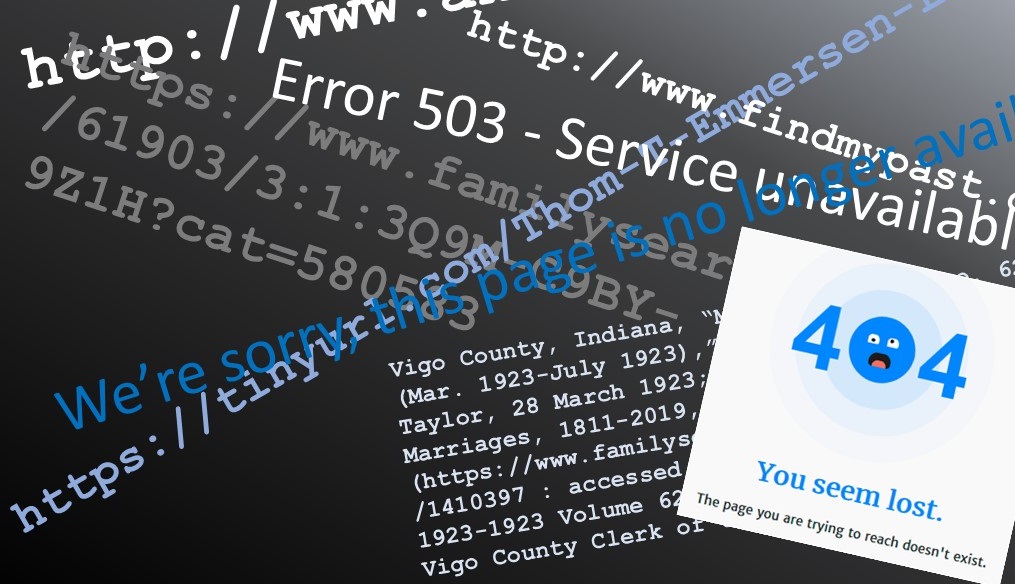There are several issues with including website addresses (also known as URLs) in citations. The first is that they can be very long, and the second is that they are not always “fixed” and therefore not replicable, especially when the page is the result of a database search. Connected to that is the fact that sites can change their root URL, and pages can vanish from the web. The final aspect of this concern is the question of URLs that point to a resource on a subscription website, like Ancestry. If a person without a subscription enters the URL they will not get access to the data (though they might be invited to take out a subscription 😊).

Regarding the first issue, there are ways to shorten a URL. Bitly (https://bitly.com/) is one, and Tiny URL (https://tinyurl.com/app) is another. The latter is possibly preferable as you can make a meaningful abbreviation (e.g. tinyurl.com/Thom-T-Emmersen-Land). Whether or not shortening the URL is the correct way to go is a matter for debate.
As for the second problem, some sites have created what is known as a persistent identifier URLs or persistent identifiers, which continue to give consistent access to a page. Unfortunately, these are also very long. Also, many sites do not have persistent identifiers. You can typically recognise a persistent identifier as they often contain PAL or ARK in them, e.g. https://www.familysearch.org/ark:/61903/3:1:3Q9M-C9BY-9Z1H?cat=580583.
Similarly, there are DOIs (Digital Object Identifiers) which are static and are assigned to most scholarly journal articles (though they wouldn’t typically be assigned to most other types of source we use in genealogy). If a page has a DOI it can be substituted for a URL.
All this results in different schools of thought about whether full URLs should be included in a citation, or only the root URL of the site (though even that can change – many NSW government departments change their website addresses every time there is a government re-organization).
For that reason, Ian G. Macdonald, in Referencing for Genealogists: Source and Citation[1] recommends using only the root URL of those sites. In contrast, Elizabeth Shown Mills in Evidence Explained[2] recommends using “waypoints”, which are like a set of directions to find the information (e.g. go down the corridor > take a left turn > go up the stairs one flight > turn right > go in the second door on the left > go to the third bookcase on the right > find the second shelf from the bottom > the book you are looking for will be the 6th from the left).
An example using this method to cite something is as follows:
Vigo County, Indiana, “Marriage Record no. 62 (Mar. 1923-July 1923),” 16, Lee Shick-Alice Taylor, 28 March 1923; imaged, “Indiana Marriages, 1811-2019,” FamilySearch (https://www.familysearch.org/search/collection/1410397 : accessed 1 October 2023) > Vigo > 1923-1923 Volume 62 > image 60 of 340; citing Vigo County Clerk of the Court, Terre Haute.[3]
Speaking personally, and this is only my opinion, I don’t like this method any more than using a URL that may change. The reason is that the structure of these websites can (and has in the past) change, and the path specified may no longer be valid. Several of the examples in Evidence Explained no longer get you to the expected place, even though the latest edition of the book was only published this year. Thinking about the example I gave above of finding a book in a library, it’s very likely that over time more books will be added, so that the book in question will no longer be the 6th book from the left in the second bottom shelf.
One strategy that can be used with Ancestry and Findmypast (and possibly other sites) is to include the collection name in the citation, and then use the Card Catalog (Ancestry) or the “All Record Sets” search option (Findmypast) to find the relevant collection and go from there. But even a collection name can change. In 2017 Ancestry had a collection titled “California Passenger and Crew Lists, 1882-1959”. In 2024 it is called “California, U.S., Arriving Passenger and Crew Lists, 1882-1959”. A subtle difference, and not one that stops us from finding the correct collection, but still a difference. I know this is confusing, and I’m not giving you an ideal answer, but sometimes there IS no ideal solution. You just have to be aware of these dilemmas and make your own decisions.
[1] Ian G. Macdonald, Referencing for Genealogists: Source and Citation (Stroud, Gloucestershire: The History Press, 2018) pp. 27-28.
[2] Elizabeth Shown Mills, Evidence Explained: Citing History Sources from Artifacts to Cyberspace, 4th ed. (Baltimore, Maryland: Genealogical Publishing Company, 2024) pp. 69-70.
[3] Mills, Evidence Explained, p. 422.